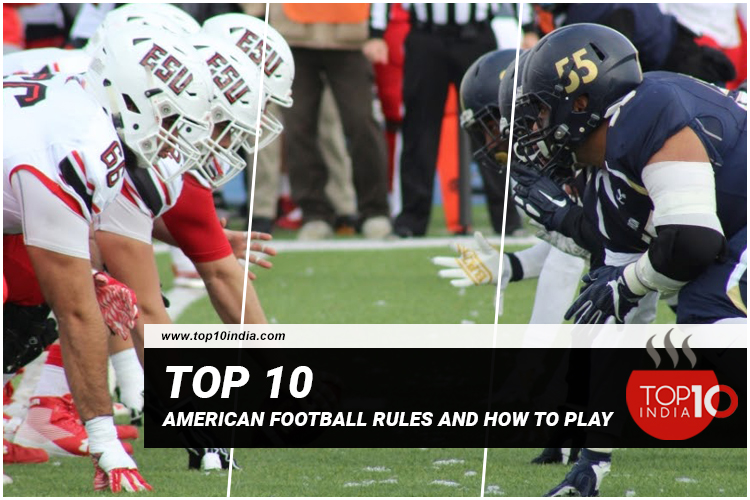Top 10 American football rules and how to play:- American football, referred to simply as football in the United States and Canada and gridiron, is a team sport played by two teams of eleven players on a rectangular field goalpost at each end. American football evolved in the United States, originating from the sports of soccer and rugby.
Top 10 American Football Rules And How To Play
In this list, we have mentioned the Top 10 American football rules and how to play. Here we will provide you all the rules and some instructions about how to play football. If you’ve ever wondered about the basics of how to play American-style football, you are not alone. American football can seem like many guys repeatedly crashing into each other until you understand some of the basics and start to see the strategy involved.
No.1 Understanding rules and terminology
American football aims to score points by carrying the ball from a starting point on a 120-yards long and 53.3-yard wide field into a specially marked 10-yard deep area at either end of the field called an end zone. Each end zone has a Y-shaped structure called the field goal position on the end line. it is the first rule in the list of the Top 10 American football rules and how to play
- The end zone that a term is defending is usually referred to as “their” end zone. Thus, a team with 70 yards to go before it can score a touchdown is 30 yards from its end zone.
- Teams trade possession of the ball according to strict rules. whichever team is in possession of the ball is known as the “offense”; the other team is called the “defense.”
No.2 Scoring in American Football
The ultimate aim of the team in American football is to score more points than the opposition. Scoring is worked out in the game as follows:-
- Touchdown(6 Points):- A touchdown is scored when a team crosses the opposition’s goal line with the ball or catches or collects the ball in the end zone.
- Field Goal(3 Points):- A team will usually attempt these on the fourth down – if the kicker is close enough to the end zone to kick the ball through between the upright posts.
- Extra point(1 or 2 Points):- An extra point is earned by kicking the ball through the upright after a touchdown. Two points are earned by taking the ball into the end zone again, but most teams opt to take the 1 point since it is more difficult.
- Safety(2 Points):- The defensive team can gain 2 pts if they tackle a member of the offensive team with the ball in their own end zone.
No.3 Downs
Downs are the part of the game which often needlessly confuses newcomers. They are actually fairly straightforward. In a nutshell, the rule is as follow:-
- The team in possession of the ball (offense) needs to move the ball forward by at least 10 yards while they are on offense. This is why the pitch has clearly marked yardage lines on it.
- They have four chances, or downs, to gains those 10 yards, and if they advance the ball that far, the count resets, and the team earns another set of four downs to try to go a further 10 yards.
- If the offensive team fails to move these 10 yards within four downs, possession is then given up, and the defensive side gets their turn to play offense. Teams will usually kick for a field goal or downfield to the defending team on the fourth down to try and salvage some points before they lose possession.
No.4 Learn the time division.
- Football is divided into four quarters of 15 minutes each, with a break between the second and third periods called “halftime” that is normally 12 minutes long. While the clock is active, the game is divided into even shorter segments called “plays” or “downs.”
- Playtime can stop for a few reasons: If a player runs out of bounds, a penalty is called, a flag is thrown, or a pass is thrown but not caught by anybody, the clock will stop while referees sort everything out.
- Penalities are indicated by referees, who throw yellow flags onto the field when they see a violation. This lets everyone on the field know that a penalty has been called. Penalties normally result in the offending team losing between 5-15 yards of field position.
No.5 The opening kickoff
- At the very beginning of the game, the head referee flips a coin will be face up. If correct, that captain may choose to kick off or receive the opening kickoff or allow the visiting team captain to choose.
- Once the kicking and receiving teams are decided, the team captain who lost the coin toss gets to decide which goal their team will defend during the first half.
- This initial play is called kickoff and typically involves a long kick downfield from one team to another. The team kicked the ball, rushing towards the team receiving the ball to prevent them from running the ball a long way back towards the kicking team’s end zone.
- After halftime, there is a second kickoff by whichever team did not perform the opening kickoff.
No.6 Fight your way forward with running plays.
- Generally, the most common type of play seen in football is the running play. Running plays tend to yield less yardage per the other team.
- They have the added advantage of getting the football out of the quarterback’s hands quickly before an aggressive defense can reach his position and cost the team extra yards.
- If the ball is dropped during a running play, it is called a fumble. A fumbled ball can be picked up by either the other team or the team that fumbled it to gain or control it.
No.7 Equipment
- Flag:- The main equipment used by the officials is the yellow flag. When the officer sees a penalty, they throw a yellow flag, so the players, coaches, fans, and other officials know there has been a penalty.
- Whistle:- Officials blow a whistle to indicate that a play is over and the players should stop.
- Uniform:- Officials wear a black and white striped shirt and white pants.
- Bean Bag:- The Bean Bag is thrown to mark where a punt was caught, or a fumble recovered.
No.8 Defense Basics
- Tackling:- Tackling is the number one skill all defensive players must have. It doesn’t matter how fast you are, how well you shed blockers, or how prepared you are; if you can’t tackle, you won’t be a good defensive player.
- Run Defense:- The first goal of any defense is to stop the run. All the players work together to do this. The defensive lineman tries to take on blockers while they corral the runner. They try to keep the runner from getting around the outside. At the same time, the linebackers come up to fill in any holes.
- Pass defense:- Pass defense is becoming increasingly important as passing has become a huge part of most offenses. Again, all the defensive players must work together to have a good pass defense. The secondary and linebackers cover the receivers while the linemen rush the quarterback.
No.9 Passing route
- Hook or Hitch Route:- In the hook or hitch route, the receiver runs up the field a certain distance and then quickly stops and turns back the quarterback to catch the ball. The receiver makes a slight hook pattern moving back in the direction of the quarterback.
- Slant Route:- In the slant route, the receiver goes a short distance down the field and then quickly cuts at a 45-degree angle across the middle of the field. This is a great route against blitz defenses or where a quick pass is needed.
- Out Route:- An Out Route is where the receiver runs straight down the field for a certain distance and then runs “out” directly towards the sideline. A normal out will go for 10-15 yards downfield before turning toward the sidelines. A “quick” out is a short out of ground 5 yards.
- In or Dig route:- The In route or dig route is similar to the out, but where the receiver cuts at a 90-degree angle to the middle of the field.
No.10 Offense Basics
- Blocking:- An important part of any offensive play is blocking. This is where offensive players get in the way of defensive players to prevent them from tackling the player with the ball. Blockers may not hold onto defensive players making this difficult task.
- Running Plays:- On running plays, the quarterback may run with the ball or hand it off to a running back. A receiver may sprint through the backfield on one rare occasion and receive the ball for a running play.
- Passing Plays:- In a passing play, the quarterback drops back and throws the ball to an eligible receiver. Typically, there is a primary receiver for a play, but the quarterbacks will look to other receivers if that is covered. Players that catch the ball include wide receivers, slot receivers, tight ends, and running backs.
FAQ
1.What are the main rules of American football?
The game lasts for four 15 minutes quarters. 2 minutes break between the 1st & 2nd and 3rd & 4th quarters is had along with a 15 minutes rest between the 2nd and 3rd quarters.
2. How do you explain a girl to football?
The scoring- spell out the points given for a touchdown, kick after, field goal, and, on occasion, two-point conversion. Save the safety for a future discussion.















Be First to Comment